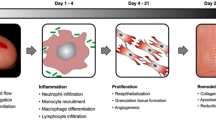Abstract
Scar tissue is the result of all wound healing processes. This has major implications for the patient, as scar tissue is usually less mechanically resistant, is aesthetically displeasing, and can cause functional impairment through contractures and itch. The extent of scar formation is mostly influenced by the duration and extent of the inflammatory phase of wound healing. Shortening the inflammatory phase can lead to healthier scar tissue. After wound healing, a number of early interventions have been shown in various studies to be beneficial for the development of normal mature scars, such as immobilization, different topical treatments, and compression. The best documented among the topical treatments is silicone as a gel or sheets. In case of hypertrophic scarring or keloid formation, the best evidence is available for intralesional treatments, classically intralesional corticosteroids. Newer intralesional treatments with slightly increased efficacy and less side effects include the intralesional application of 5-fluorouracil or bleomycin. Cryotherapy which can also be performed intralesionally sometimes provides a more effective option. All of these treatments, along with numerous other less documented treatments, have in common that they have varying results and usually need to be applied over long time periods. Surgical correction of disturbing scars should only be performed after scar maturation and in the case of keloids only in combination with other modalities such as intralesional injections or radiotherapy.
Access this chapter
Tax calculation will be finalised at checkout
Purchases are for personal use only
Similar content being viewed by others
Abbreviations
- 5-FU:
-
5-Fluorouracil
- DNA:
-
Deoxyribonucleic acid
- Gy:
-
Gray
- IL:
-
Interleukin
- ROS:
-
Reactive oxygen species
- TGF:
-
Tumor growth factor
- TNF:
-
Tumor necrosis factor
References
Gauglitz GG, Korting HC, Pavicic T, Ruzicka T, Jeschke MG. Hypertrophic scarring and keloids: pathomechanisms and current and emerging treatment strategies. Mol Med. 2011;17(1–2):113–25.
Gauglitz GG, Kunte C. [Recommendations for the prevention and therapy of hypertrophic scars and keloids]. Hautarzt. 2011;62(5):337–46.
Atkinson JA, McKenna KT, Barnett AG, McGrath DJ, Rudd M. A randomized, controlled trial to determine the efficacy of paper tape in preventing hypertrophic scar formation in surgical incisions that traverse Langer’s skin tension lines. Plast Reconstr Surg. 2005;116(6):1648–56; discussion 57–8.
Shin TM, Bordeaux JS. The role of massage in scar management: a literature review. Dermatol Surg. 2012;38(3):414–23.
O’Brien L, Jones DJ. Silicone gel sheeting for preventing and treating hypertrophic and keloid scars. Cochrane Database Syst Rev. 2013;9:CD003826.
Monstrey S, Middelkoop E, Vranckx JJ, Bassetto F, Ziegler UE, Meaume S, et al. Updated scar management practical guidelines: non-invasive and invasive measures. J Plast Reconstr Aesthet Surg. 2014;67(8):1017–25.
Khansa I, Harrison B, Janis JE. Evidence-based scar management: how to improve results with technique and technology. Plast Reconstr Surg. 2016;138(3 Suppl):165S–78S.
Gold DA, Sheinin R, Jacobsen G, Jones LR, Ozog DM. The effects of postoperative intralesional corticosteroids in the prevention of recurrent earlobe keloids: a multispecialty retrospective review. Dermatol Surg. 2018;44(6):865–9.
Fitzpatrick RE. Treatment of inflamed hypertrophic scars using intralesional 5-FU. Dermatol Surg. 1999;25(3):224–32.
Shah VV, Aldahan AS, Mlacker S, Alsaidan M, Samarkandy S, Nouri K. 5-fluorouracil in the treatment of keloids and hypertrophic scars: a comprehensive review of the literature. Dermatol Ther (Heidelb). 2016;6(2):169–83.
Hietanen KE, Jarvinen TA, Huhtala H, Tolonen TT, Kuokkanen HO, Kaartinen IS. Treatment of keloid scars with intralesional triamcinolone and 5-fluorouracil injections – a randomized controlled trial. J Plast Reconstr Aesthet Surg. 2019;72(1):4–11.
Jones CD, Guiot L, Samy M, Gorman M, Tehrani H. The use of chemotherapeutics for the treatment of keloid scars. Dermatol Rep. 2015;7(2):5880.
Gupta S, Jangra RS, Gupta S, Mahendra A, Gupta S. Creating a guard with a needle cover to control the depth of intralesional injections. J Am Acad Dermatol. 2016;75(2):e67–8.
Ragoowansi R, Cornes PG, Moss AL, Glees JP. Treatment of keloids by surgical excision and immediate postoperative single-fraction radiotherapy. Plast Reconstr Surg. 2003;111(6):1853–9.
Author information
Authors and Affiliations
Corresponding author
Editor information
Editors and Affiliations
Rights and permissions
Copyright information
© 2020 Springer Nature Switzerland AG
About this chapter
Cite this chapter
Läuchli, S. (2020). Scar Management. In: Alavi, A., Maibach, H. (eds) Local Wound Care for Dermatologists. Updates in Clinical Dermatology. Springer, Cham. https://doi.org/10.1007/978-3-030-28872-3_20
Download citation
DOI: https://doi.org/10.1007/978-3-030-28872-3_20
Published:
Publisher Name: Springer, Cham
Print ISBN: 978-3-030-28871-6
Online ISBN: 978-3-030-28872-3
eBook Packages: MedicineMedicine (R0)




